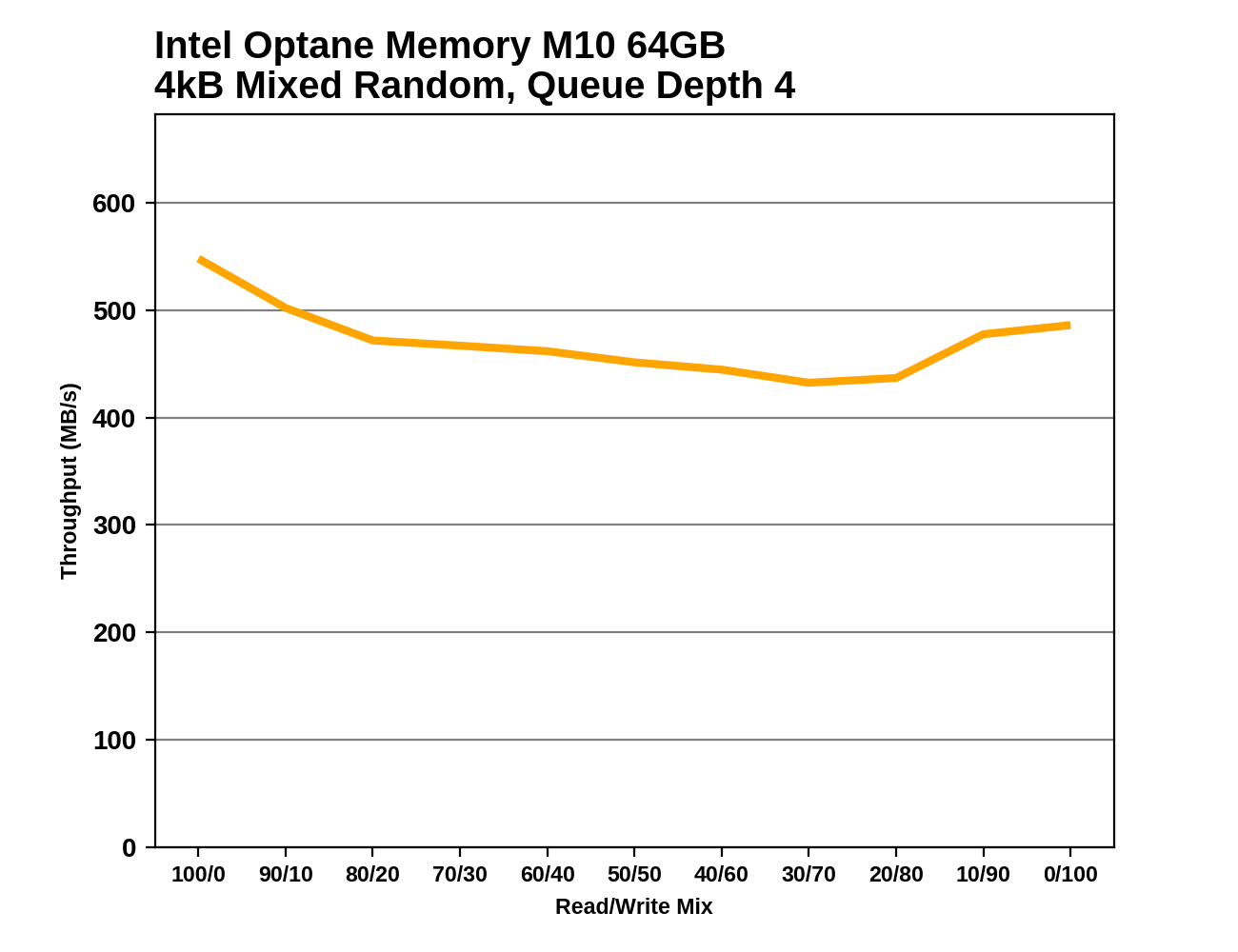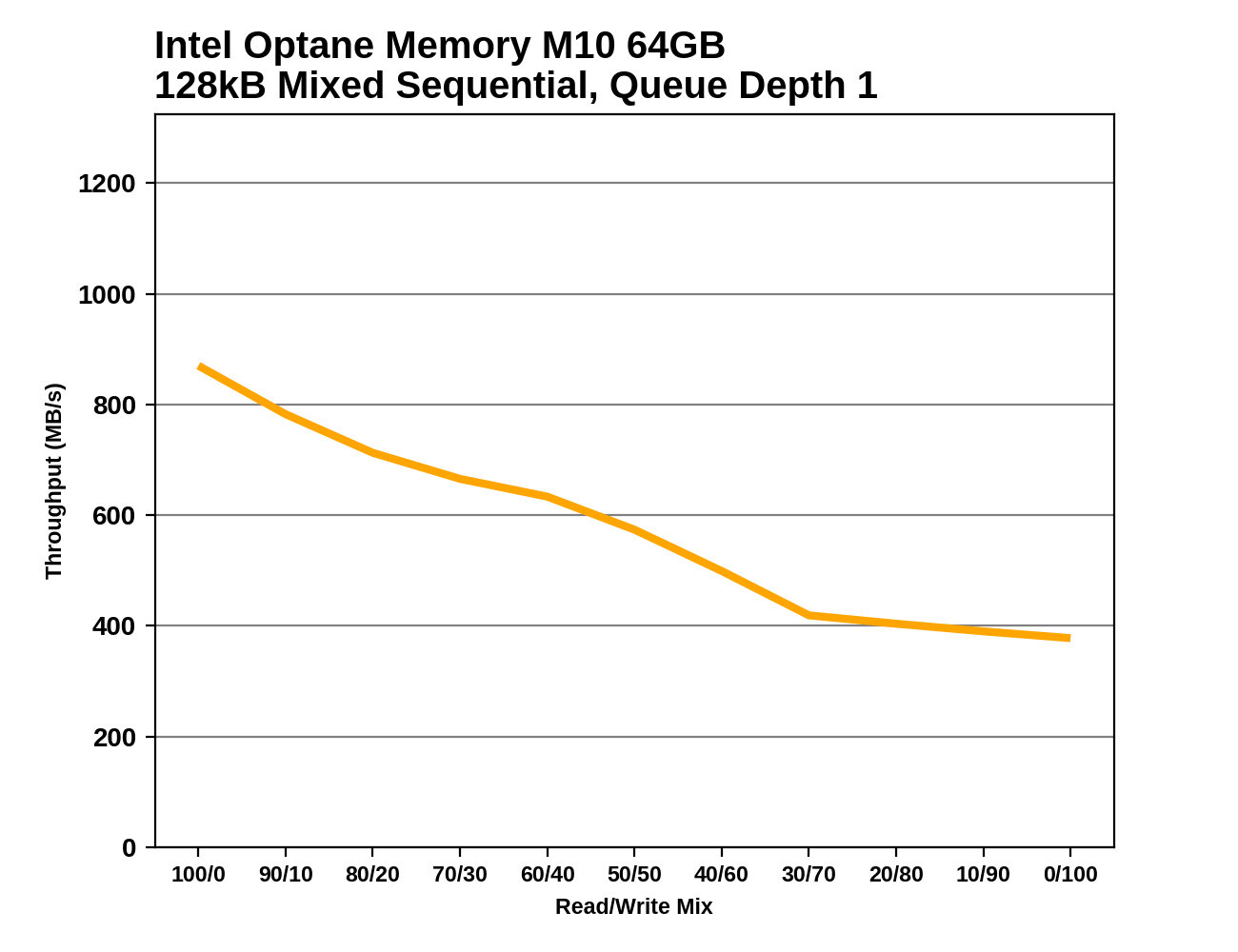The Intel Optane Memory M10 (64GB) Review: Optane Caching Refreshed
by Billy Tallis on May 15, 2018 10:45 AM EST- Posted in
- SSDs
- Storage
- Intel
- PCIe SSD
- SSD Caching
- M.2
- NVMe
- Optane
- Optane Memory
Mixed Random Performance
Our test of mixed random reads and writes covers mixes varying from pure reads to pure writes at 10% increments. Each mix is tested for up to 1 minute or 32GB of data transferred. The test is conducted with a queue depth of 4, and is limited to a 64GB span of the drive. In between each mix, the drive is given idle time of up to one minute so that the overall duty cycle is 50%.

Unsurprisingly, the mixed random I/O test produces crap performance from the hard drive and the two cache configurations where the cache is too small for this test. The 118GB Optane SSD 800P is more cache than this test needs, and it performs almost as well as the Optane SSD 900P.
 |
|||||||||
When used as a cache for this test, the largest Optane SSD 800P shows slightly different performance characteristics than when it is treated as a standalone drive, but in either case it is a strong performer across the board. The smaller Optane drives aren't large enough to cache the entire working set of this test and can't do much to improve performance over the hard drive.
Mixed Sequential Performance
Our test of mixed sequential reads and writes differs from the mixed random I/O test by performing 128kB sequential accesses rather than 4kB accesses at random locations, and the sequential test is conducted at queue depth 1. The range of mixes tested is the same, and the timing and limits on data transfers are also the same as above.

All of the Optane configurations easily outperform the SATA drives on the mixed sequential I/O test. The 64GB and 118GB modules are tied when tested as standalone drives and close when tested as cache devices, and the cache performance is 30-40% faster than the standalone SSD performance. The 32GB module is substantially slower and performance is much closer between caching and standalone SSD use.
 |
|||||||||
The performance improvements in the caching configurations over the standalone drive configurations generally apply throughout the mixed sequential test. The main exception is in the early phases of the test with the 32GB cache, where cache performance falls far short of the standalone drive performance. Once the proportion of reads has dropped to 70%, the cache configuration comes out ahead.










96 Comments
View All Comments
philehidiot - Tuesday, May 15, 2018 - link
"Fud" is also an excellent Scottish swear word. I particularly enjoy using it due to it's brutal bluntness.ianmills - Tuesday, May 15, 2018 - link
Intel was the one who claimed a coffee lake motherboard was needed for optane. Most likely the slow speed has to do with the spectre/meltdown fix that greatly slows down disk operations done in different user spaces on Intel chipsbananaforscale - Tuesday, May 15, 2018 - link
Oh but it *is* proprietary, you just don't know what the word means. Look it up. It *doesn*t* imply anything about compatibility.nevcairiel - Wednesday, May 16, 2018 - link
All hardware really is, so the only argument anyone could reasonably make would be about the interface/compatibility when using that word.evernessince - Wednesday, May 16, 2018 - link
No reason to buy with an AMD motherboard though, as AMD is handing out StoreMI for free with X470 boards. StoreMI is superior as well.Klimax - Friday, May 18, 2018 - link
Interesting lack of evidence...Dr. Swag - Tuesday, May 15, 2018 - link
Still don't see why a user should choose a 64gb optane drive over, say, a 500gb mx500, which you could use 64gb for caching using RST. The performance difference between optane and an mx500 won't be noticeable when doing normal stuff like booting up and launch apps.WithoutWeakness - Tuesday, May 15, 2018 - link
There are a lot of folks who use their computers for more than just running Chrome and a few games. Many people with professional workflows have storage drives in the 4-8+ TB range but only need to work with ~50-100GB of data at a time. In these scenarios the active data will be automatically cached on the Optane drive and their workflows can be greatly accelerated without the need to copy it to a separate SSD scratch drive before working on it. If you have so little data that you can just run off of a 500GB SATA SSD then obviously just buy the MX500.iwod - Tuesday, May 15, 2018 - link
Surely the same can be done for SSD Boot Drive, this is more of a software advantage then a hardware advantage.CheapSushi - Wednesday, May 16, 2018 - link
You can use Optane drives like any SSD though. Even if these are being marketed as a caching only thing, you can still use it however you like. Want to pay less to try out software caching? Get the cheaper one then and try it out.